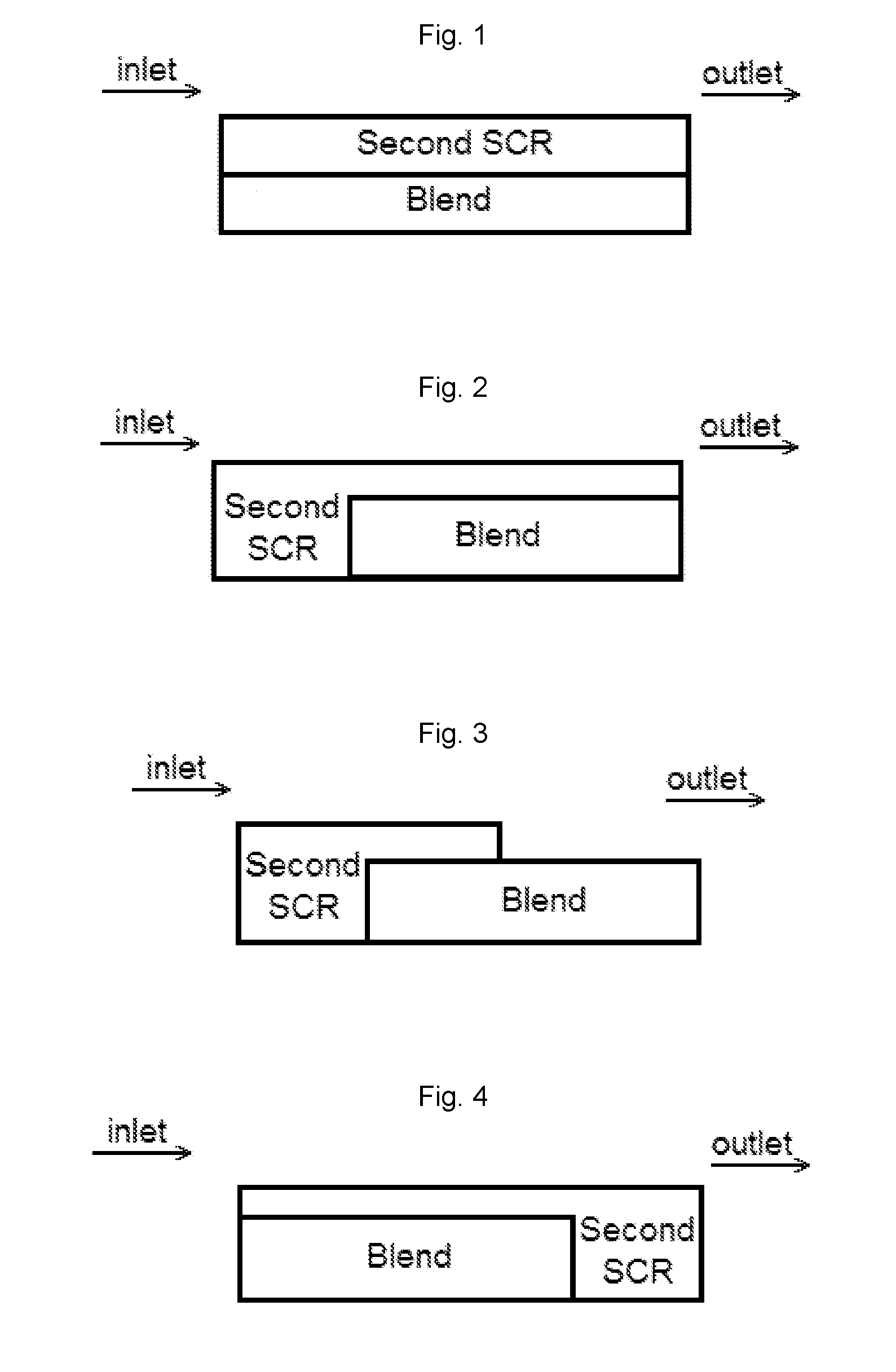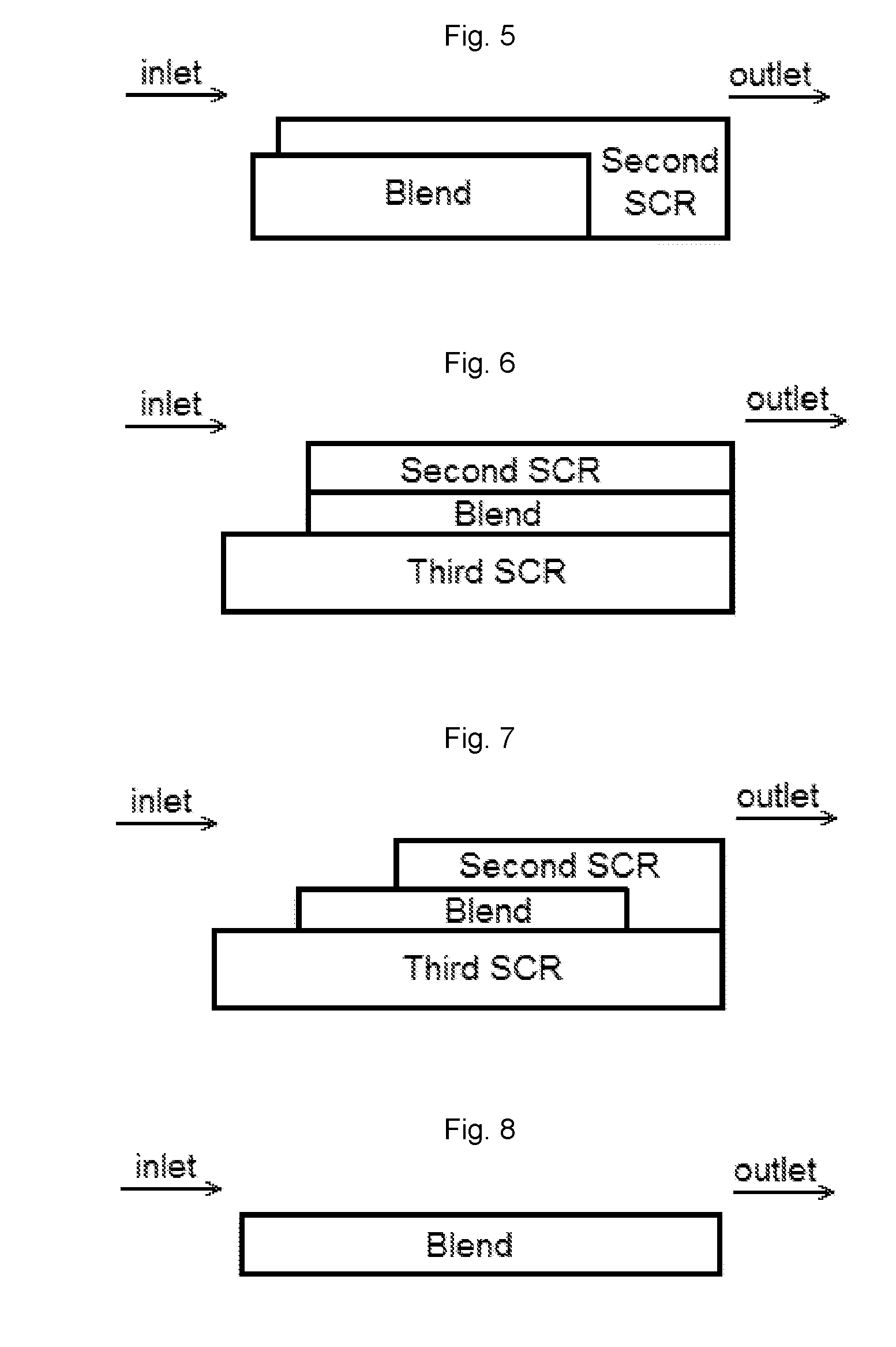Ammonia slip catalyst with low n2o formation
a slip catalyst and ammonia technology, applied in the field of ammonia slip catalysts, can solve the problems of reducing the n2 yield of ammonia, so as to improve the n2 yield. , the effect of improving the n2 yield
- Summary
- Abstract
- Description
- Claims
- Application Information
AI Technical Summary
Benefits of technology
Problems solved by technology
Method used
Image
Examples
example 1
Bilayer Blend of 1 wt. % Pt on MFI Zeolite (SAR=2100) with Cu-CHA in the Bottom Layer and Cu-CHA in the Top Layer with the Full Length of the Pt Bottom Layer Covered by the Cu-CHA Top Layer
[0085]A bottom layer comprising a washcoat comprising a blend of 1 wt. % Pt on a ZSM-5 (MFI framework with SAR=2100) and a Cu-CHA (copper chabazite) was applied to a ceramic substrate. The washcoat was pulled down the substrate using a vacuum. The article was dried and calcined at about 500° C. for about 1 hour. The loading of Pt, the high SAR zeolite and the Cu-CHA on the article was 3 g / ft3, 0.18 g / in3, and 1.8 g / in3, respectively.
[0086]A top layer comprising a second washcoat comprising a Cu-CHA was applied to the substrate coated with the bottom layer, and then the washcoat was pulled down the substrate to a distance of about 50% of the length of the substrate using a vacuum. The article was dried and calcined at about 500° C. for about 1 hour. The loading of Cu-CHA in the top layer was 1.8 g / ...
example 2
Bilayer Blend of 2 wt. % Pt on MFI Zeolite (SAR=2100) with Cu-CHA in the Bottom Layer and Cu-CHA in the Top Layer with the Full Length of the Pt Bottom Layer Covered by the Cu-CHA Top Layer
[0087]A bottom layer comprising a washcoat comprising a blend of 2 wt. % Pt on a ZSM-5 (MFI framework with SAR=2100) and a Cu-CHA was applied to a ceramic substrate, then the washcoat was pulled down the substrate using a vacuum. The article was dried and calcined at about 500° C. for about 1 hour. The loading of Pt, the high SAR zeolite and the Cu-CHA on the article was 3 g / ft3, 0.09 g / in3, and 0.9 g / in3, respectively.
[0088]A top layer comprising a second washcoat comprising a Cu-CHA was applied to the substrate coated with the bottom layer, and then the washcoat was pulled down the substrate to a distance of about 50% of the length of the substrate using a vacuum. The article was dried and calcined at about 500° C. for about 1 hour. The loading of Cu-CHA in the top layer was 1.8 g / in3. The artic...
example 3
Bilayer Blend of 2 wt. % Pt on Amorphous Silica with Cu-CHA in the Bottom Layer and Cu-CHA in the Top Layer with the Full Length of the Pt Bottom Layer Covered by the Cu-CHA Top Layer
[0089]A bottom layer was applied to a ceramic substrate using a washcoat comprising a blend of 2 wt. % Pt on an amorphous silica and a Cu-CHA. The washcoat was applied to a ceramic substrate, and then the washcoat was pulled down the substrate using a vacuum. The article was dried and calcined at about 500° C. for about 1 hour. The loading of Pt, the high SAR zeolite and the Cu-CHA on the article was 3 g / ft3, 0.09 g / in3, and 0.9 g / in3, respectively.
[0090]A top layer was applied to the substrate coated with the bottom layer using a second washcoat comprising a Cu-CHA, and then the washcoat was pulled down the substrate to a distance of about 50% of the length of the substrate using a vacuum. The article was dried and calcined at about 500° C. for about 1 hour. The loading of Cu-CHA in the top layer was 1...
PUM
| Property | Measurement | Unit |
|---|---|---|
| Temperature | aaaaa | aaaaa |
| Temperature | aaaaa | aaaaa |
| Temperature | aaaaa | aaaaa |
Abstract
Description
Claims
Application Information
 Login to View More
Login to View More - R&D
- Intellectual Property
- Life Sciences
- Materials
- Tech Scout
- Unparalleled Data Quality
- Higher Quality Content
- 60% Fewer Hallucinations
Browse by: Latest US Patents, China's latest patents, Technical Efficacy Thesaurus, Application Domain, Technology Topic, Popular Technical Reports.
© 2025 PatSnap. All rights reserved.Legal|Privacy policy|Modern Slavery Act Transparency Statement|Sitemap|About US| Contact US: help@patsnap.com



